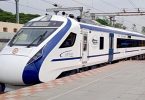In a keynote speech delivered to the Northeast Climate Policy Forum, Amtrak president and CEO Joseph Boardman explained why passenger rail should be part of any strategy that addresses climate concerns and energy issues. Amtrak has been working towards becoming a greener railroad, and President Boardman shared his company’s efforts in this regard.
The forum was sponsored by The Climate Registry, a non-profit organization founded to set consistent and transparent standards for businesses and governments to calculate, verify, and publicly report their greenhouse gas emissions. Amtrak joined the group in 2009 and is the first railroad to commit to the organization’s comprehensive reporting standards for recording and managing greenhouse gas emissions throughout its system including those from diesel and electric locomotives, passenger rail cars, maintenance equipment, stations, offices, and other facilities.
“Amtrak’s ridership grew every fiscal year between 2000 and 2008,” Boardman said in his March 16 speech. “We set a record for total ridership in 2007 and broke it in 2008. Even in the teeth of a major recession, we still managed to post our second-best year ever in 2009, and we have just turned in the strongest first-quarter ridership in our company’s history.”
Affirming that rail is an essential component of any strategy for addressing climate and energy issues, Boardman said, “No one mode is a solution to the transportation problem because no single mode can provide the whole range of qualities that will both satisfy travelers and address vital public policy needs. The optimal solution, from a public policy perspective, is one that identifies the conditions under which each transportation mode provides the optimal mobility choice and directs funding accordingly. To get there, America needs a true multi-modal transportation policy, one that strategically funds outcomes rather than blindly funding mode-centric formulas. Creating this shift in public policy is key to our future and to achieving our goals.
“Congress took a first step in that direction when it passed the Passenger Rail Investment and Improvement Act of 2008, or PRIIA. PRIIA sets national policy and establishes authorized funding levels for intercity passenger rail through 2013. Since the passage of the original Rail Passenger Service Act in 1970, Amtrak has been through numerous reauthorizations. PRIIA is, however, a major departure from previous legislation, because it incorporates several programs designed to promote the development of intercity passenger rail and to tie that development to desired policy outcomes.
“The most important policy change in PRIIA is the shift of responsibility for the development of new services toward the states. PRIIA establishes a capital fund that provides states an 80-20 match; the states are expected to commit to covering operating costs. We currently have partnerships with 15 states, and we expect to develop more in the coming years. I say that because the American Recovery and Reinvestment Act of 2009 provided states with an initial US$8 billion in funding. More than half of that money will go to state projects that will improve trip time, reliability, or capacity on planned or existing Amtrak routes.”
Boardman also discussed the environmental advantages rail can offer. “As you probably know, transportation is responsible for approximately a third of the greenhouse gas emissions in the United States,” he said. “Highway travel, which provides the foundation for intercity auto travel, generates 75 percent of the transportation sector’s carbon and accounts for 75 percent of the transportation sector’s energy use. Rail, by contrast, is a lower-carbon and lower-energy solution. Railroads as a whole, freight and passenger, generate only 3 percent of transportation-related CO2 emissions. I would note parenthetically that Amtrak and the commuter railroads combined generate about two-tenths of a percent of the transportation industry’s total. With a miniscule percentage of the total carbon emissions, you might think that the railroads carried only a miniscule percentage of the freight traffic, but in fact, they carried more than 42 percent of the freight ton-miles generated in America in 2009.”
Amtrak’s diesel fuel consumption and carbon emissions fell by 8.5 percent from 2000 to 2008, while ridership grew more than 27 percent over the same period, Boardman said. Discussing Amtrak’s recent success in reducing greenhouse gas emissions, Boardman noted: “A lot of our specific measures have been focused on reducing the use of diesel fuel. As you all know, fuel prices have been very volatile over the last couple of years and a jump in the price of diesel fuel can translate into a big jump in our operating costs. To address this, we have taken a whole range of measures that are designed to lower fuel consumption, save fuel, and reduce emissions.”
In California, Amtrak is experimenting with ultra-low sulfur fuel and has just begun a trial with bio-diesel fuel in Oklahoma. It’s been training engineers to operate locomotives in a fuel-conserving manner, to reduce idling, and to handle the train as efficiently and carefully as possible. “These programs,” said Boardman, “have been very successful, and the success is reflected in our reduced consumption of diesel fuel and our emission levels. We have actually come in below our targeted CO2 emissions levels in every year from 2004 to 2009.” Recently, Climate Counts, a non-profit organization which provides an independent and verifiable assessment of a company’s commitment to reduce its impact on the environment and climate, named Amtrak one of six companies to receive a high enough score to earn Climate Counts’ top designation, along with such companies as Ben & Jerry’s, REI, and Timberland.
“Effective though our diesel emissions reduction program is, Amtrak has also done some exciting things with its electrified services,” Boardman said. “I’m a big fan of electrified railroading for a lot of reasons. A big one is that it has the potential to produce extremely low emissions; if we can buy green power, we can drastically lower the emissions footprint of the railroad. Another important one is that all future operations over 110 mph will probably have to be electric. Amtrak’s Northeast Corridor operations are almost completely electrified. We run our Northeast Regional and Acela trains behind electric power between Washington, New York, and Boston.
“The construction of a completely new electric system to power trains between New Haven and Boston was a major project, managed by Amtrak, and completed in 2000. We also reintroduced electrified service on our Philadelphia to Harrisburg line in 2006. Electrification is a vital component of high-speed service and it makes our trains truly time-competitive with the airlines, and the customers know it. In 2009, we carried more people between Washington and New York, and between New York and Boston, than all the airlines put together. This hasn’t always been the case, and a lot of the ridership growth is a product of the Boston-New Haven electrification and the Acela service. When we run fast, frequent trains from city center to city center, you can really make a 200- to 300-mile service trip time-competitive with the airlines, and that is exactly what we have done.”
In 2000, on the Boston-New York run, Amtrak carried about 20 percent of the passengers in the market it shares with the airlines. Back then the trip took close to five hours. Today, the trip time has been cut to about three and a half hours, and Amtrak carries about 51 percent of the air-rail market. On the Washington-New York leg, which has had more time to develop as a high-speed service, it carries more than 60 percent.
“The ability,” Boardman said, “of competitive intercity passenger rail service to obviate the need for energy-intensive, short-haul flights such as Boston-New York and New York-Washington is an important climate policy consideration, as 39.5 percent of flights at our nation’s 10 largest airports cover routes of 500 miles or less – a distance that could more efficiently be served by rail.”
Amtrak is supporting an initiative known as the Clean, Low-Emission, Affordable, New Transportation Efficiency Act, or “CLEAN TEA.” CLEAN TEA, which was introduced in the Senate by Sens. Thomas Carper (D-Del.) and Arlen Specter (D-Pa.), and in the House by Reps. Earl Blumenauer (D-Ore.), Ellen Tauscher (D-Calif.), and Steven LaTourette (R-Ohio), is a bipartisan measure that recognizes the need to invest in modes of transportation that pollute the least and that includes intercity passenger rail. Funding would be distributed by the Department of Transportation and the Environmental Protection Agency to transportation projects designed to reduce greenhouse gas emissions from the transportation sector and address other public policy needs.
“Over the long run,” Boardman said, “we will require substantially higher levels of funding than we can currently obtain if we are to realize large-scale improvements in the intercity passenger rail system we will need to make if we are going to attract passengers away from more energy-intensive modes. We have enjoyed tremendous support from the environmental community in recent years, and we are working with The Climate Registry to realize our goal of a safer, greener, and healthier company.” For more information, call 800-USA-RAIL or visit www.amtrak.com .





















